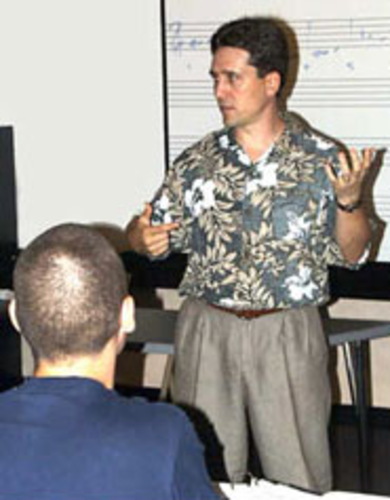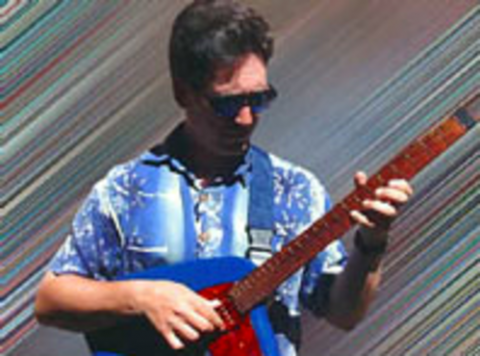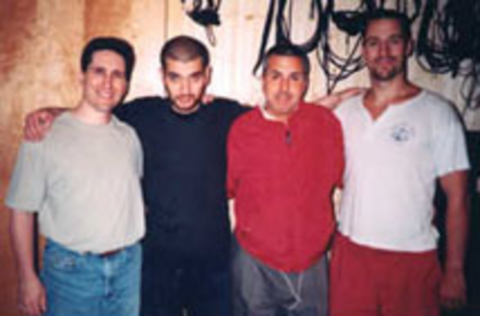Reelin' in the Ears

Mitch Haupers is one of Berklee's most popular ear training teachers.

Mitch infuses free improvisation with an accessible beauty on his recent quartet recording.

Mitch teaches all levels of core Ear Training and Rhythmic and Harmonic Ear Training electives.

The Mitch Haupers Quartet, from left to right: Mitch Haupers (guitar), Vardan Ovsepian (piano), Bob Weiner (drums), Joshua Davis (bass)

The cover of the CD, "Somewhere Out There," recently recorded by the Mitch Haupers Quartet.
I walked into my second semester of ear training with the same attitude I had walking into the first. I couldn't see any connection whatsoever between "Do-Re-Mi" and the music I was making at the time. Nothing at Berklee had been more nerve-racking for me than singing solfege in front of a class. My alienation mutated into a combination of fear and despair as my teacher, Mitch Haupers, began the semester by leaping into harmonic ear training, jazz tunes, and sight singing. Before long, we were performing vocal duets, reading three-part rhythms and of course, doing plenty of the dreaded dictation. It was a lot of work, but I was doing surprisingly well. Then, everything fell apart when I got an ear infection and lost my hearing in one ear.
Everything I heard sounded strange and everything I sang came out wrong. After my grade began plummeting, I went to see Mitch at his office to explain. He gave me a bunch of practice ideas, and he was even able to see a possible upside to my ear infection. "Here's your chance to really develop your inner hearing," I remember him saying. "Don't worry about singing, just work on hearing the pitches inside your head."
Inner hearing. It's one of those concepts people told me about, but I couldn't really understand until I had experienced it. Thanks to Mitch and the obstacle presented by my infection, I finally started to get it. After meeting with Mitch, I went back home and practiced in a completely new way. I didn't sing, I just thought of the pitches, and a door opened in my musical imagination. I had never experienced how powerful the "inner ear" could be. To think of the melody to "Happy Birthday" is one thing, but to look at sheet music and use solfege to realize a melody I had never really heard, blew my mind. I began to get a lot more out of class and started to truly appreciate how much Mitch had to offer as a teacher.
One of Mitch's specialities is providing several approaches for tackling ear training challenges, always providing the easiest option first. For example, I used to stumble when I tried to count an odd time, like 7/8. But after Mitch suggested thinking of a common phrase, like "Hon-o-lu-lu-Ha-wai-i," I found it a lot easier to feel the meter. Mitch introduced me to the Lydian-flat-7 mode when he gave a homework assignment to transcribe the Simpsons theme song, which is based on the mode. That was one project the whole class enjoyed. And jazz, something that always felt alien to this corrupted child of the MTV generation, suddenly became accessible when Mitch had me and the rest of the students sing duets of "I Got Rhythm" from chord symbols.
"As many people as there are trying to learn something, there are that many ways to relate to it," Mitch says. Difficult as you might think it would be to teach a class of 20 students under that premise, that's exactly what Mitch does.
The way Mitch teaches is a logical extension of the approach he has applied to his own music studies. Even at a young age, when he began piano lessons, Mitch found himself searching for his own path to learning.
"I didn't like the lessons mainly because of the constrictions they were putting on me," Mitch says. "It was stopping me from enjoying it. Even as a kid, I was happy just hearing the sound when I hit a note and said 'whoa!' Whatever I'm doing, I'll get in deep, learn how to do it, and go to the next thing. I see myself changing and growing constantly."
After completing a bachelor's degree in composition, theory, and jazz performance at DePaul University in Chicago, Mitch discovered the innovative guitar work of Mick Goodrick and traveled from the Midwest all the way to Boston in the mid-1980s. "I came to Boston as a result of hearing Mick's 'In Pas(s)ing' (ECM, 1978). I just had to find Mick and be around him," says Mitch, who had learned Goodrick was teaching at New England Conservatory. "There was something about the colors and feeling created by that ensemble. I love the sound of the bass clarinet. I was intrigued by the tunes, which seemed to revolve around the changes mostly. Mick's harmonic approach to the guitar was a revelation to me—fingerstyle jazz! But, it was more than that and I knew it at the time. I had never felt so drawn toward anything."
Mitch moved to Boston, enrolled at NEC, and earned a master's degree in Third Stream Studies, Guitar Performance. After graduating, he helped Third Stream chair and pianist Ran Blake restructure the department and managed his performing career. As a faculty member at NEC, Mitch taught Third Stream repertoire ensembles and private lessons before leaving in 1989 for a faculty position at Berklee.
Mitch Haupers has worked in a number of behind-the-scenes jobs in the recording industry, produced jazz festivals, and done a range of work for a guitar manufacturer, among other experiences (for more details, see "Mr. Versatility" below). He is currently working on educational publications for Mick Goodrick and the recording artists Yellowjackets and holds endorsements from Klein Electric Guitars and Brian Moore Guitars. He has played in big bands and small ensembles of all kinds and sizes.
These lists are not here to impress, but to show that people like Mitch are out there. I'm talking about the kind of people who know that dedicated study is important but also know they don't have to spend all their time practicing their scales in a closet, listening to one musician obsessively, or falling into any routine that so many musicians believe is the only path to success. Mitch's multifaceted career inspires students like myself who just hear "music," and just want to do "music." All of it. "I'm not someone who sees categories," Mitch says. "To me, golf is music. So is pool. So is teaching. It's kind of a way of moving through the world. It's all music to me."
By encouraging Berklee graduate Susan Cattaneo '98 to see the music in everyday life, Mitch helped her overcome lifelong struggles with rhythm.
"Mitch changed the way I look at the world," says Cattaneo, who joined Berklee's songwriting faculty last year."In Rhythmic Ear Training class, he had us look out the windows on Mass. Ave. and figure out the time signatures of all the people walking by. I saw this one guy walking down the street pushing along his bicycle. He was walking in 2/4 and the bike spokes were moving in 3/4. It was like the three-over-two time we had just been studying in class. Mitch helped me realize that I had been living with rhythm in my life all along."
One of Mitch's key life lessons came during a trip to Europe in the 1980s. As tour manager for a traveling orchestra, he met and observed people whose easy, in-the-moment ways of living came to inform his own approach to life and music.
"People really enjoyed what they did," Mitch says. "When I was desperately in need of a ride, I met a cab driver in Switzerland who gave me a free ride on his day off—just so he could listen to his Chick Corea tapes with someone else who dug it. I watched people in Klagenfürt, Austria, going through the day with smiles on their faces, just enjoying things like keeping the place clean in front of their shop. Every person I met at a little family-owned market in Paris was extremely nice to me even though I spoke little French. It was something that I took home with me. I get as much gratification out of building guitars as out of playing music, as out of teaching. I just keep trying to do whatever I do as best I can and enjoy it from moment to moment."
Mitch's positive attitude and ability to focus on the task at hand are clearly evident in his teaching style and career path. His advice for multi-directional students like me? "Find out the place you're at and make an honest assessment of yourself. Realize that things fluctuate and there's no plateau you're going to reach. Just learn to enjoy what you do and the process of doing it," Mitch says.
Making music by enjoying it in the moment is a "Mitch philosophy" that manifests itself most clearly in his explorations of free improvisation. It's the coming together of the two things he's done most intensely his entire musical life: listening and playing. Those two activities merge in free playing, an approach to music foreign to far too many Berklee students.
"Can you imagine when there are no rules?" Mitch asks. "No music, no nothing. Just go in and play? Everything goes, but at the same time if you're respectful of the music and each person you're playing with, you have to listen the whole time. It's the perfect place for putting ear training into action. I want to make it more visible in the curriculum at Berklee because I think people need to experience it. My interest is to get people to play like this to learn about themselves."
Mitch taught a free playing ensemble for two semesters on his own time and is pushing for it to become a permanent class. He stresses the fact that in free playing, each person is responsible for every sound they make. There's no style, no plan, no memorized riff that's going to sound good. That's why Mitch says it's a great way to learn about your own musical voice and how to communicate with others.
"It strips away all the emotional and psychological baggage that we can bring to a playing situation and that can make it hard to create musical focus," Mitch says. "I try to get musicians to let go of their preconceived notions and limitations about playing. We use very focused ideas such as new form structures, time constraints, specific emotions or dynamics as points of departure. These 'constrictions' prevent them from focusing on ego-oriented subjects. 'How do I look?' 'How do I sound?' 'What do others think of my playing?' It's a good window into your soul. When it's done honestly, everything is laid bare. There you are."
Mitch has always been careful to avoid playing in any strictly stylistic way. He credits Steely Dan as one of the first bands he heard that opened his ears to the wide scope of sounds available to any musician.
"When my brother turned me on to them my reaction was, 'Wow! Every tune's got a different guitar sound or a different approach,'" Mitch says. "I didn't want to sound like somebody else. I try to learn not only to listen to other people and make their sounds part of my vocabulary, but try to make them my own as well. I try to uncover the ways in which I emerge through the music."
I was amazed when I listened to Mitch's music. He played me a CD that he had recently recorded with his "free" quartet. What I had expected would be formless avant-noise was instead 11 tracks of beautiful music. There were all kinds of sounds, forms, ideas, and grooves.The attention paid to space was extraordinary. It was clear that everyone was listening and finding the right place at just the right times. (See links above to listen to excerpts from Mitch's CD.)
Mitch talked about how each tune came about, some based on an abstract idea to help add interest or a simple restriction to create more form. In the past Mitch has played to paintings and even from poetry as sources of inspiration. "I remember using the poem 'Now We Are Six,' by A.A. Milne as the catalyst for a trio piece we recorded in Chicago," Mitch says. "I even asked one quintet to think of Ichabod Crane and we created this hip groove piece called 'The Headless Horseman.' For 20 years now I have been getting musicians together to play in this way. They are often pleasantly surprised by the experience–it is artistically very broadening. The result of free playing is not always finely crafted pieces. The process is more important; finding your own voice and what the music needs."
"I'm not the only one doing this, " Mitch says. "(Guitar professor) Jon Damian has been teaching this way at the school for a long time. I remember hearing this story of a goldfish bowl on stage with a few goldfish in it. Everybody was assigned a particular fish, had to watch their fish, follow their fish and play the fish.There's (Woodwind Professor and saxophonist George) Garzone's avant-garde ensemble. (Faculty member and trombonist) Hal Crook's doing it in his workshops. And one of the great experiences I had studying with Mick at NEC was his free playing ensemble."
Mitch brings the freedom and spontaneity of his playing with him to the classroom every day. I wanted to understand why someone with Mitch's skills would decide, of all things, to teach ear training, a class many students would rather delete from the Berklee curriculum. When you consider the real value of ear training, how rudimentary it is to all music, and how deeply Mitch has explored it, the connection it has to Mitch's many talents becomes a little clearer. Perhaps the rewards of a life dedicated to learning and helping others learn are greater than those of the performer, the composer or any of the other roles Mitch has played. Maybe they are of a different kind altogether.
Mr. Versatility
There seems to be no end to the type of music-related work Mitch Haupers has done and continues to do. Here's a short excerpt from his resume:
Mitch has worked in public relations and sales for the recording industry, art design and promotion for a major record distributor, and production, set-up, and quality control for a major guitar manufacturer. He is experienced in jazz festival production and concert management for MacArthur Award recipients and world-famous jazz artists, orchestral management and touring. He has played in a wide range of ensembles and performed in professional theater and NAMM industry shows.
Mitch has helped publish, develop and edit a series of voice-leading books for Mick Goodrick and he is collaborating with the recording artists Yellowjackets on a transcription series and multimedia project focused on music education. He has multiple artist/educator endorsements which include Klein Electric Guitars and Brian Moore’s award-winning iGuitar 2000™ series MIDI controller guitars. He is involved in research and development for cutting-edge technological applications including music distance learning modules with iDL Systems, Inc. and real-time performance and MIDI applications for Mark of the Unicorn, Inc.
